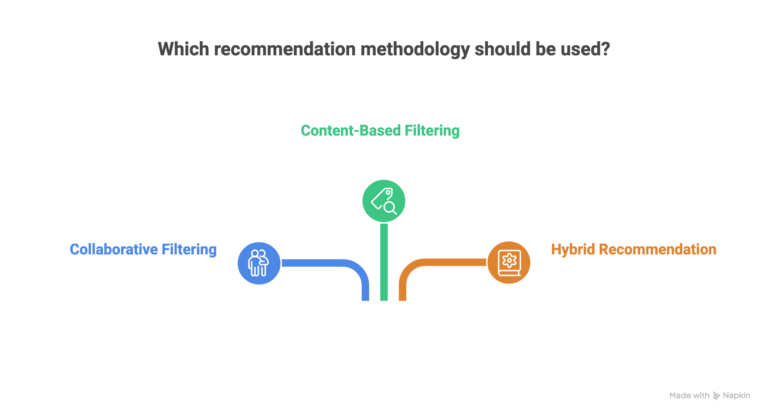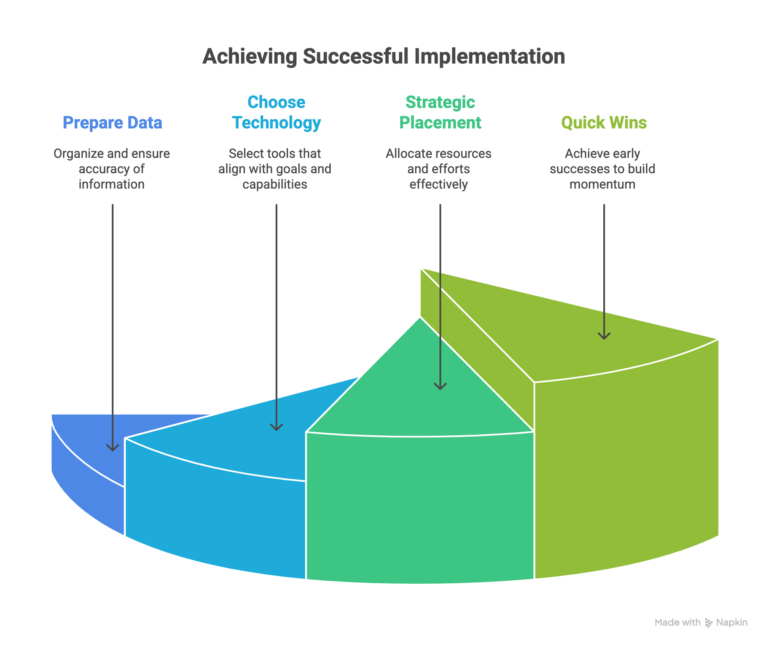Greetings! I'm Aneesh Sreedharan, CEO of 2Hats Logic Solutions. At 2Hats Logic Solutions, we are dedicated to providing technical expertise and resolving your concerns in the world of technology. Our blog page serves as a resource where we share insights and experiences, offering valuable perspectives on your queries.

Quick Summary
AI product recommendations use machine learning algorithms to analyze customer behavior and suggest relevant products automatically. Businesses implementing AI-powered product recommendations see 15-30% higher conversion rates, a 35% revenue increase, and a 25% increase in average order value. This guide covers how recommendation systems work, implementation tactics, and proven strategies to maximize ROI.
AI product recommendations are intelligent systems that analyze customer data to suggest relevant products at the right moment. Unlike manual curation, e-commerce product recommendations powered by machine learning adapt in real-time based on browsing patterns, purchase history, and contextual signals.
Today’s shoppers encounter AI recommendation engines everywhere: personalized homepage galleries, “frequently bought together” sections on product pages, abandoned cart recovery emails, and post-purchase cross-selling campaigns. The shift from manual to AI-driven recommendations represents a fundamental change in customer personalization, moving from static rules to dynamic, data-driven suggestions that improve with every interaction.
How AI Recommendation Systems Work
Modern AI-powered product recommendations rely on three core approaches:

Collaborative Filtering
This method identifies patterns among users with similar behaviors. Suppose customers A and B both purchased items X and Y, and customer A also bought item Z. In that case, the system recommends Z to customer B. Collaborative filtering excels at discovering unexpected connections but struggles with new products that lack behavioral data.
Content-Based Filtering
Content-based filtering analyzes product attributes, categories, colors, materials, and price points to suggest similar items. If a customer views running shoes, the recommendation algorithm suggests other athletic footwear based on shared characteristics. This approach works well for new inventory but can create repetitive suggestions.
Hybrid Recommendation Models
The most effective machine learning product recommendations combine both approaches. Hybrid systems leverage collaborative filtering’s pattern recognition while using content-based filtering to fill gaps, creating more accurate and diverse suggestions. This combination addresses the cold start problem when launching new products or onboarding first-time visitors.
Key Data Inputs:
- Behavioral: Page views, time on site, scroll depth, click patterns
- Transactional: Purchase history, cart additions, abandoned items
- Contextual: Device type, location, time of day, referral source
WARNING: Poor data quality produces poor recommendations. Ensure your product catalog includes accurate attributes, categories, and metadata before implementing any recommendation system.
Schedule a free consultation to discover which AI recommendation strategy
Business Impact & ROI
The ROI of AI recommendation systems is backed by compelling data. Companies implementing AI conversion optimization report transformative results:
- 35% revenue increase from personalized product recommendations
- 15-30% higher conversion rates compared to non-personalized experiences
- 4X increase in conversion rates for businesses using advanced machine learning algorithms
- 25% increase in average order value through strategic upselling recommendations
The $8.65 billion AI e-commerce market reflects widespread adoption; 89% of companies now use AI-driven recommendations in some capacity. Beyond immediate sales metrics, AI personalization in online shopping significantly reduces cart abandonment and improves customer satisfaction scores, driving repeat business and lifetime value.
Real-World Impact: One mid-sized fashion retailer saw their average order value jump from €47 to €61 within 90 days of implementing AI recommendations, with minimal additional marketing spend.
Implementation Tactics
Implementing AI product recommendations requires strategic planning, not just technology deployment:

1. Prepare Your Data
Clean your product catalog by standardizing categories, enriching descriptions, and adding relevant attributes. The recommendation system’s accuracy depends entirely on this foundation.
2. Choose Your Technology
Evaluate AI recommendation engines based on:
- Integration is easy with your platform (Shopify, WooCommerce, Magento)
- Algorithm sophistication (hybrid models outperform single-method systems)
- Customization capabilities for your industry
- Transparent reporting and attribution tracking
3. Strategic Placement
Deploy recommendations where they deliver maximum impact:
- Homepage: “Recommended for You” sections personalized to browsing history
- Product Pages: “Customers Also Bought” and “Complete the Look” widgets
- Cart: Cross-selling AI suggestions before checkout
- Email: Abandoned cart recovery with personalized alternatives
- Post-Purchase: Complementary product suggestions 3-5 days after delivery
4. Start with Quick Wins
Launch pilot tests on high-traffic product categories. Run A/B experiments comparing manual curation against AI recommendations. Most businesses see measurable improvements within 2-3 weeks, providing early validation for broader rollout.
PRO TIP: Don’t wait for perfect data. Modern AI recommendation engines improve continuously as they collect more behavioral signals. Starting small allows the system to learn while you optimize.
Weekly Insights
Get our best content delivered to your inbox every week.
Best Practices & Optimization
Success with AI-powered product recommendations requires ongoing refinement:
Regular Algorithm Tuning
Review performance metrics monthly. Adjust recommendation rules for seasonal products, inventory levels, and margin considerations. Machine learning models benefit from human oversight to align with business objectives.
Avoid Common Mistakes
- Overfitting: Don’t show only bestsellers, introduce variety to discover new customer preferences
- Irrelevant Suggestions: Filter out incompatible products (suggesting iPhone cases to Android users)
- Recommendation Overload: Limit widgets to 4-6 products per section to avoid decision paralysis
Solve the Cold Start Problem
For new products without behavioral data, combine content-based filtering with featured placements. For new visitors, use popular items segmented by category or rely on contextual signals like referral source.
Privacy Considerations
Implement transparent data collection practices. Ensure compliance with GDPR, CCPA, and other regulations. Offer customers control over personalization settings to build trust.
WARNING: Over-aggressive personalization can feel invasive. Balance relevant suggestions with user privacy by avoiding recommendations based on sensitive product categories without explicit consent.
Measuring Success
Track these core KPIs to evaluate your recommendation engine:
Primary Metrics:
- Conversion Rate: Percentage of visitors who purchase after viewing recommendations
- Click-Through Rate (CTR): Engagement with recommendation widgets
- Average Order Value: Revenue per transaction influenced by cross-selling AI
- Revenue Attribution: Sales directly linked to recommendation interactions
Secondary Metrics:
- Recommendation Coverage: Percentage of products appearing in suggestions
- Diversity Score: Variety within recommended items
- Return on Investment: Incremental revenue versus system costs
Review performance weekly for new implementations, then shift to bi-weekly or monthly optimization cycles. Use attribution tracking to isolate recommendation impact from other marketing activities.
PRO TIP: Create separate reports for different recommendation types (homepage vs. email vs. cart). Each placement serves distinct purposes and requires tailored optimization approaches.
Conclusion
The best AI recommendation engines for e-commerce combine sophisticated algorithms with practical business logic. Whether you’re just starting with AI personalization in online shopping or optimizing an existing system, the data is clear: how AI product recommendations boost conversions is no longer theoretical; it’s measurable, repeatable, and essential for competitive e-commerce.
Ready to implement AI recommendations? Start with one high-impact placement, measure results rigorously, and expand based on proven performance. The technology has matured to where even small businesses can access enterprise-grade customer personalization.
FAQ
What are AI product recommendations, and how do they differ from traditional suggestions?
AI product recommendations use machine learning to analyze customer behavior, preferences, and context to provide personalized product suggestions in real-time. Unlike traditional rule-based suggestions, AI adapts dynamically and improves accuracy over time.
What are the key benefits of AI-powered product recommendations for e-commerce?
Benefits include increased conversion rates (up to 30%), higher average order values, reduced cart abandonment, enhanced customer experience, and greater customer retention through personalization.
What challenges should I expect when using AI product recommendations?
Common challenges include the cold start problem for new products and customers, data privacy compliance, and ensuring relevant recommendations without overwhelming customers.

Related Articles








